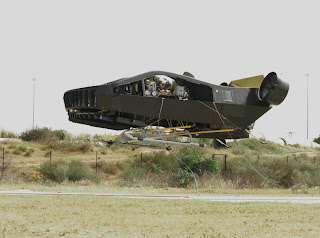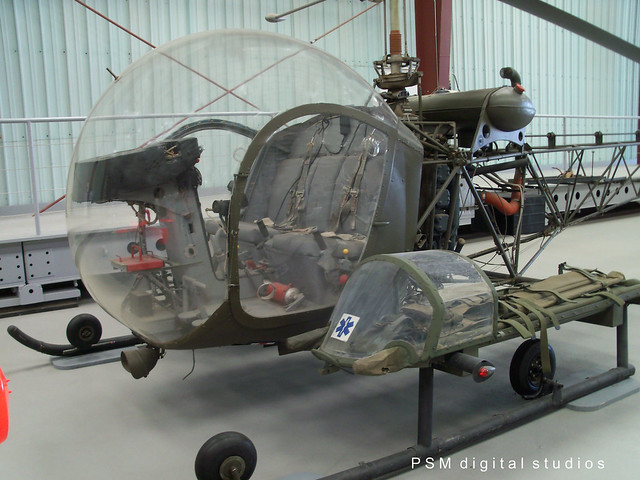The Rise of Radical New Rotorcraft
At a secret facility, aerospace engineers are plotting to end the helicopter as we know it, and devising new rotorcraft to replace it.
By Jeff Wise
The building doesn't look like much—one of several nondescript hangars alongside an airstrip on the edge of the Everglades, baking in the eternal monotony of the central Florida sun.
This is the home of Sikorsky Aircraft's Area 31, where the company works on its most advanced rotorcraft projects. Like Area 51, the famously clandestine Air Force base in the Nevada desert, this airfield is home to experimental aircraft being built and tested. The mystery projects here need to be kept not only from other nations but from other aviation companies too. Millions, possibly billions, of dollars are at stake. For that reason, Sikorsky is hesitant to let journalists onto the grounds and does so only if the tour is restricted and the photography limited.
Inside the hangar, bathed in fluorescent light from banks of industrial lamps, is a molasses-dark fuselage with unusual twin fins jutting vertically from its tail. The fin structures are vertical stabilizers with rudders built in. Even at a glimpse, the half-finished airframe is something new.
This is the S-97 Raider. When it takes to the air in 2015, it will be the first production-ready prototype for a new kind of rotorcraft, the compound-coaxial helicopter. The Raider has two rotors that turn in opposite directions on a central mast, enabling it to fly up to 275 mph. That's more than 100 mph faster than a conventional helicopter, giving it twice the range.
The S-97 is among an emerging generation of advanced craft that could redefine the meaning of vertical-lift aviation. In 2011 the Army funded the Joint MultiRole Rotorcraft Technology Demonstrator (JMR-TD) program. This is the first step in an effort to replace the military's entire inventory of helicopters. Retired first will be the UH-60 Black Hawk, to be replaced with the Future Vertical Lift Medium, at the earliest in 2030.
The FVL Medium will have big shoes to fill. The Black Hawk provides the bulk of vertical-lift capability for the U.S. Army, Navy, Marines, Special Operations Command, and Coast Guard. It first entered service with the Army in 1979; over the next 30 years, more than 2300 aircraft saw service at home and abroad. The Black Hawk and its variants have proven track records but are limited by a maximum speed of 183 mph.
Aside from the FVL Medium, the Pentagon envisages three other classes of future flying machines that will have roots in this program: the FVL Light, to replace the Kiowa scout helicopter; the FVL Heavy, to replace the brawny twin-rotor Chinook; and the FVL Ultra, a brand-new class of aircraft that would combine the hauling capacity of a C-130 cargo plane with the ability to take off vertically. If the Pentagon plan comes together, these machines will replace every U.S. military helicopter.
Changes on the battlefield are posing dangers for traditional helicopters. Longer range missiles can target bases and ships, putting helicopter staging areas at risk. Aircraft that can fly faster and travel farther can complete their missions with less risk. And, since more capable rotorcraft can cover more ground, the Pentagon can buy fewer of them.
Today's most advanced vertical-lift aircraft is the V-22 Osprey, used by the Marine Corps and U.S. Special Operations Command. The Osprey tilts its rotors 90 degrees to fly like an airplane and land like a helicopter. But the Army is looking for a smaller combat rotorcraft instead of an Osprey-size heavy lifter. The JMR Technology Demonstrator will be designed to carry 11 troops, compared with the Osprey's carry capacity of 24.
The other type of vertical aircraft is the jump jet, which can vector its engines toward the ground to hover. Examples include the AV-8B Harrier and F-35B Lightning II, both carrier-capable fighter airplanes. These are not well-suited as Army utility lifters and attack helos because they burn too much fuel and are not light or maneuverable enough to fly missions close to the ground.
The goal of the JMR-TD program is to create an aircraft that is as nimble as today's Black Hawk while hovering, but with a ferry range of 2100 miles and a cruise speed of more than 265 mph. Industry engineers declare that it's possible, but the Pentagon launched the JMR-TD program to be convinced. "It's an investment to inform ourselves about the technology that's available," Dan Bailey, the Army program's director, says. "What we are looking at is a leap ahead in capability."
Last year the Army narrowed the field to four JMR-TD competitors, including two giants—Sikorsky of Stratford, Conn., and Bell Helicopter of Hurst, Texas—and two tiny firms, AVX Aircraft Company of Benbrook, Texas, and Karem Aircraft of Lake Forest, Calif. Each was awarded $6 million to produce a design. This summer two of the four will be selected to turn that design into hardware, with flight tests from 2017 to 2019.
The Army has made it clear that whoever survives the downselect will not necessarily be the winner of a $100 billion production contract for building as many as 4000 aircraft. But even losing companies stand to gain by flying demonstration aircraft, since the JMR-TD designs will inspire versions suitable for civilian markets.
In a few decades these futuristic rotorcraft could be as common in the skies as conventional helicopters are today. "This is a step change," says Steve Weiner, Sikorsky's director of engineering sciences. "It's going to be similar to when fixed-wing airplanes went from piston to jet engines."
If next-generation rotorcraft will be more capable than today's fleet, they are also going to be considerably more expensive. It takes a lot of power to go fast, and bigger engines add both weight and cost. "If you want to go above 150 knots [173 mph], you're going to have to pay a premium of 50 to 100 percent," says Richard Aboulafia, an aviation analyst with the Teal Group. Pentagon-funded demonstrator programs allow manufacturers to work out the kinks of new designs and bring down prices.
"Looking downstream, it's obvious that there's certain commercial applications of this technology," Bell's Keith Flail says. Some niches will be easier to exploit than others. "Offshore oil rigs could be a market," Aboulafia says. With exploration moving into ever-deeper waters, a vehicle that can make twice as many trips ferrying rig workers in the same amount of time will be worth the steep price tag to the big energy companies.
Another potential market, Aboulafia says, is the VIP market. Corporate executives and other wealthy individuals already take helicopters on short-hop trips, but more advanced rotorcraft could ferry passengers as far as 500 miles, avoiding airport hassles.
In a more critical application, medevac, speed can mean the difference between life and death. "There's a thing called golden hour," AVX's Troy Gaffey says. "If you can get someone to a hospital within that time, they're a lot more likely to live."
If these early markets pan out for tilt-rotors or compound-coaxial helicopters, there's no telling how many other uses they'll have. Right now vertical lift means a conventional helicopter, with niches occupied by the jump jet and the tilt rotor. Some day that relationship could reverse, if this new generation of vertical-lift aircraft becomes the norm, relegating conventional helicopters to the fringe. "You'll see the ratio change in that direction," Flail predicts confidently. "The evolution is coming."
What Makes Helicopters So Slow?
When a helicopter is stationary, its rotor blades move at the same speed relative to the air. But when a helicopter flies forward, the blades on the advancing side move faster, relative to the wind, and the blades on the retreating side move slower.
As soon as the helicopter's forward speed matches the speed at the tip of the rotor, the retreating rotor tip momentarily experiences zero airspeed. At that point the rotor is generating no lift, a phenomenon known as retreating-blade stall. With half the rotor disc no longer holding the aircraft up, the helicopter tends to roll to the side. This aerodynamic principle limits conventional helicopters to about 200 mph.
The Contenders
Sikorsky
Coaxial Rotors: Sikorsky's entry in the Black Hawk replacement program is the SB-1 Defiant. With a top speed of more than 300 mph, the Defiant will be faster than the company's internally funded S-97 Raider. The Defiant uses two rotor discs that move in opposite directions to defeat retreating-blade stall. Counter-rotating rotors have an advancing blade on each side of the aircraft, giving balanced lift at all speeds. Advanced composites make the blades extremely stiff, so they can whir through the air in proximity without hitting each other.
Pusher Prop: This rear-mounted propeller provides extra thrust. "It's an incredible sensation to realize that you're at the cruise-power setting of a normal helicopter but going 250 mph," Sikorsky chief test pilot Kevin Bredenbeck says.
Bell Helicopter
Tiltrotors: Bell is building its entrant, the V-280 Valor, based on its experience with the V-22 Osprey tiltrotor. The smaller, nimbler version will be able to carry 11 soldiers 264 miles, hover for 30 minutes, and return at 320 mph. No need to worry about retreating-blade stall: To go fast, pilots toggle a thumb wheel that tilts the twin rotors 90 degrees, transforming them into propellers. The Valor's two engines will be fixed in a horizontal position, with only the rotors pivoting up and down. The Valor will sport flexible rotor blades for a new level of maneuverability at low speeds, while still providing the range and efficiency that no traditional helicopter can match.
Side Doors: "The bread-and-butter mission for the Army is air assault," V-280 program director Keith Flail says. "When soldiers are coming into a landing zone, they need clear fields of view and clear fields of fire out the sides of the aircraft."
Karem Aircraft
Optimum Speed Tiltrotors: Karem's TR36TD concept uses twin tiltrotors to achieve a top speed in level flight of more than 420 mph. The company developed a technology, the Optimum Speed Tiltrotor, that allows the pilot to adjust the revolutions per minute of the rotor depending on the phase of flight. The rotors don't need extra power to turn during forward flight, so decreasing their rpm increases efficiency.
AVX
Ducted Fans: AVX's design relies on a compound-coaxial helicopter like Sikorsky's, but with rotors that are lighter and more flexible, saving weight and therefore reducing power requirements. A pair of ducted fans on the rear of the airframe will give AVX's as-yet-unnamed rotorcraft extra speed. The rotors and the ducted fans push the demonstrator up to a maximum of 265 mph.
Forward Canards: In cruise mode, much of the lift will come from a pair of canard wings near the nose. "Based on our analysis, the coaxial-compound helicopter will outperform a conventional helicopter, and the cost will be essentially the same," AVX president Troy Gaffey says.




